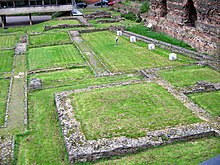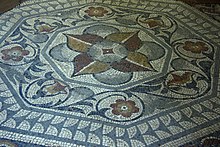Ratae Coriel favorite
Ratae Corieltavorum (also Ratae Coritanorum ) is the ancient name of the Roman Leicester , in the province of Britain . The city was already settled in pre-Roman times and was one of the main places of the Corieltauvi , a Celtic tribe. In Roman times it was the main place of the Civitas of the Corieltauvi.
With the conquest of Britain by the Romans, the Corieltauvi also came under their rule. A military camp was probably built on the site of the Celtic site . The old settlement continued and developed into a vicus . Around 80 AD, the military camp was probably abandoned, although the civilian settlement continued to exist. Around 100 AD the place was provided with a checkerboard map. In the center of the city, a large open space was used as a forum , although initially there were no forum buildings. It was not until Emperor Hadrian that a real forum building with a basilica was built. Possibly this happened directly under the influence of the emperor, who visited Britain and under whom increased construction work can also be observed in other places in the province.
The forum was 118 × 81 meters in size and was thus smaller than an insula , which was therefore divided in the east by creating a new road. The forum consisted of an open space with porticos on the outer facade, which also adorned the inner courtyard. Behind it were rows of offices and shops. In the north stood the basilica.
Around the same time, a large public bath was built west of the forum. Today it is one of the best preserved thermal baths in England . Some of the ruins are still meters high. In the same insula there was also a temple which may be a mithraeum , although this interpretation is not certain. The city was supplied with water from the south by an aqueduct . At the turn of the second to the third century AD, the city received a macellum (market hall), which indicates the particular economic importance of the city.
Mosaics were found throughout the city . In 1830 a 6.30 × 6.70 meter mosaic was found in the west of the city on "Bath Lane", which shows geometric patterns and is also known as Blackfriars Pavement. It has three by three octagons that are made up of geometric or stylized vegetable motifs. The mosaic stones are very small. There is a rich color palette. The Moaik probably dates to the second century and is among the best in Britain. Another mosaic that was found near the thermal baths has a similar structure and shows a peacock in the middle. It probably also dates to the second century. In a partially excavated house to the north of the forum, extensive remains of high-quality wall paintings were recovered. They are among the best preserved in Britain.
The city only received a stone city wall in the third century. At the end of the fourth century, large parts of the city burned down. The public buildings in particular were not rebuilt, but there are indications that the place remained inhabited continuously, but initially on a modest level in the post-Roman period.
Individual evidence
- ^ Wacher: The Towns of Roman Britain , pp. 345–346.
- ↑ David S. Neal, Stephen R. Cosh: Roman Mosaics of Britain. Volume I: Northern Britain, incorporating the Midlands and East Anglia. The Society of Antiquaries of London, London 2002, ISBN 0-953-78452-5 , pp. 92-94 and 98-100.
literature
- David S. Neal, Stephen R. Cosh: Roman Mosaics of Britain, Volume I, Northern Britain, incorporating the Midlands and East Anglia , The Society of Antiquaries if London, London 2002, ISBN 0-953-78452-5 , p. 85 -108.
- John Wacher: The Towns of Roman Britain , Routledge, London / New York 1997, ISBN 0-415-17041-9 , pp. 343-262.
Web links
Coordinates: 52 ° 38 '5.6 " N , 1 ° 8" 28.7 " W.



